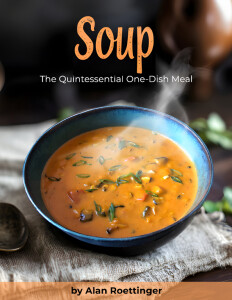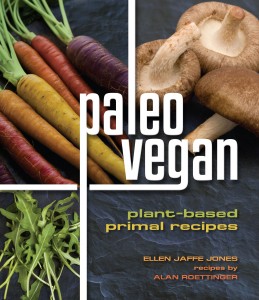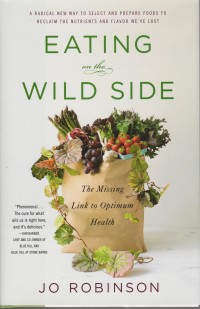One of the marvels of having a career in food is the frequent discovery of new foods. Just when I think I’ve seen pretty much everything, some undiscovered fruit, herb, grain, legume or vegetable, or a novel way of preparing them, appears before me–often in the least exotic settings, like a supermarket or roadside stand.
A few days ago, I stumbled on some visually stunning purple kohlrabi at my local natural foods store. I had only ever seen the more familiar, pale green variety, and rarely with usable tops. These were quite fresh, organic, presumably an heirloom variety, and apparently local–pretty much all of my favorite qualifications. The only test left was flavor, so I set about putting them through the rigors.
The first item that came to mind was a simple soup, which I envisioned as a pale purplish puree, with some of the cooked vegetables, along with the tops–chopped and cooked separately–added at the end for textural interest. There were two problems with this idea.
The first was that even though the soup was delicious, I failed to consider the toughness of the kohlrabi’s skin, which even after an hour of cooking remained unpleasantly resilient to the bite. I fixed this by blending all the vegetables, instead of keeping some out. The second was the final color of the soup, which had an odd, offputting, unnatural pinkish tint, neither bright enough to appeal to the eye, nor pale enough to be unnoticeable. Both of these drawbacks could have been avoided by simply peeling the vegetable, but then there would be no visual difference between these and the “regular” kohlrabi, which didn’t seem an appropriate way of dealing with the problem. The greens appeared to be heavily endowed with the toughness gene as well; they retained a texture similar to collard greens, even after simmering on their own for at least an hour.
 In the end, I had to change my entire concept for this soup. Instead of a pureed soup with tender vegetables and greens in it–since tenderness was not forthcoming–I used the simmering liquid the greens were cooking in to make a broth. I strained out about a cup of this and whisked in some Udo’s DHA Oil, for health and richness, and sriracha sauce, for heat and flavor. I added the cooked greens to the puree and reheated the mixture.
In the end, I had to change my entire concept for this soup. Instead of a pureed soup with tender vegetables and greens in it–since tenderness was not forthcoming–I used the simmering liquid the greens were cooking in to make a broth. I strained out about a cup of this and whisked in some Udo’s DHA Oil, for health and richness, and sriracha sauce, for heat and flavor. I added the cooked greens to the puree and reheated the mixture.
Then I brought the broth up to a simmer, removed it from the heat and whisked in the spicy-oily broth. This gave it a gorgeous appetizing color. I ladled the broth into bowls, and then slid in an equal amount of the puree, careful to keep them from combining. As a final touch, I added a hefty amount of coarsely chopped cilantro.
Eating it was fun–first gently stirring in a little of the cilantro, scooping up a little of the broth and a little of the puree, and letting it all combine in your mouth. Pretty spectacular, especially for what began as a minor disaster.
The other item on my mind was a finely julienned salad–grating would be too harsh, I thought–which I imagined as a combination with Granny Smith apple and celery. This one went off without a single problem. I made a very light dressing with golden balsamic, a dab of Dijon mustard, salt, pepper, and walnut oil. For color, I thinly sliced the green tops–after removing the center rib. They do have a remarkable flavor all their own, quite different from the bulb.
It was good, but it still lacked something. My wife came in and said one word: “walnuts.”
I knew instantly that she was right.
Kohlrabi, if you didn’t know, is one of the cruciferae vegetables, a very large family that includes all cabbages, kale, many salad greens, broccoli, cauliflower, radishes, mustard and horseradish. They’re all potent anti-cancer agents, and packed with equally potent flavor.
This salad is like a health elixir, combining the entire kohlrabi plant with green apple, celery, and walnuts. You can feel it nourishing you on several levels as you eat it!













Ummmm….